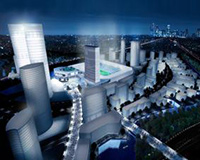It is set to become the second mayoral development corporation to be established in London. But could opposition from local councils jeopardise the £6bn regeneration of Old Oak Common?
The Greater London Authority and mayor of London Boris Johnson want to place the 195-acre project, which proposes 24,000 homes, a business district and a 40,000-seat stadium for Queens Park Rangers Football Club under the control of an MDC, enabling him to use the special planning powers that ensured the London 2012 Olympics delivered a legacy of regeneration.
But the use of the powers in west London – the proposal for which is open for consultation until 24 September – has been met with ire by Hammersmith & Fulham council.
A MDC means local councils cede control of planning powers to the GLA to determine applications and community infrastructure levy charges.
“The advantage is that an MDC provides long-term continuity of vision for sites that straddle a number of London councils,” says Ian Fletcher, director of policy (real estate) at the British Property Federation.
The disadvantage is that it removes power from local people and politicians, directly contradicting the government’s purported localism agenda.
Stratford the only example
Stratford remains the only example in London, with the London Legacy Development Corporation assuming the powers of the Olympic Park Legacy Company in 2012. Attempts to create a second in Haringey for the redevelopment of Tottenham were thrown out and a joint venture between the GLA and the north London borough established instead.
The decision to centralise power at Stratford worked because it was largely free from controversy. The affected councils – Newham, Waltham Forest, Tower Hamlets, and Hackney – were keen to capitalise swiftly on the success of the Games, so happily handed powers to the mayor.
Since then the LLDC has approved plans for a 1.2m sq ft tech hub around the Queen Elizabeth Olympic Park, E20, as well as proposals for a £45m, 431-bed student block and a 522-flat, £200m scheme adjacent to the Olympic Park.
Why wouldn’t the GLA want to replicate that success elsewhere in the capital? “[The mayor] believes that working collaboratively with all stakeholders will be vital to the success of the [Old Oak] scheme, with the huge scale of development requiring strong and clear strategic leadership,” says Sir Edward Lister, deputy mayor for planning.
The GLA also thinks the proposed MDC could maximise the benefits linked to the construction of a new HS2 and Crossrail station due to be built at Old Oak by 2026.
Hammersmith & Fulham council, on the other hand, thinks the mayor’s meddling flies in the face of localism and is convinced it could deliver the scheme using its existing planning powers.
Stephen Cowan, leader of the council, says: “The move in government over the years has been to devolve more powers to local communities, not take them away. The mayor’s proposed organisation is a throwback to decades long gone. It would be undemocratic and unnecessarily takes away powers from local residents and local businesses.”
As well as fears about the impact on local accountability, the recently elected Labour authority is worried the MDC could jeopardise its housing plans. Indeed, the formerly Conservative council was turned on the promise of delivering more housing suitable for local residents.
Changing housing policies
“We are committed to changing housing policies so that we build homes for residents rather than investment properties for overseas speculators,” says Cowan, “and we look forward to working with Ealing and Brent councils to do that.”
Ealing council is yet to submit a formal consultation response for the MDC, but a spokesman for the council says a “tri-borough arrangement could be even more effective”. He adds that regeneration schemes such as Vauxhall Nine Elms Battersea have benefited from being more locally accountable.
Brent is ambivalent, backing any “delivery focused structure”.
So do MPCs have a future in London regeneration? The GLA might champion the post-Games use of the Olympic Park as evidence of success, but it ?is clear some councils are ?unconvinced the policy provides a new blueprint for major ?regeneration projects in the capital.
And a looming election will make the GLA’s fight to win their hearts and minds all the harder.
Old Oak Common to play host to QPR
Central to the Old Oak Common regeneration is a 40,000-seat stadium for Premier League football club Queens Park Rangers.
The club, with partner Antony Spencer’s Stadium Capital Developments, has unveiled a masterplan comprising the stadium, 24,000 homes and commercial space.
A public consultation began on the Sir Terry Farrell-designed plans last week.
joanna.bourke@estatesgazette.com











